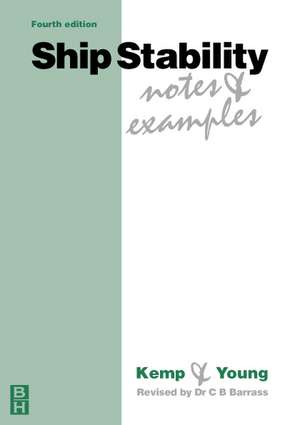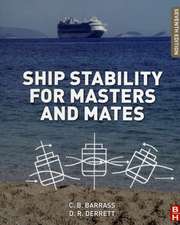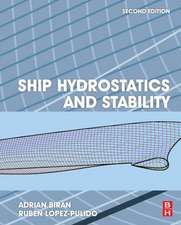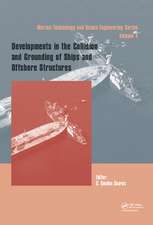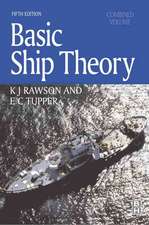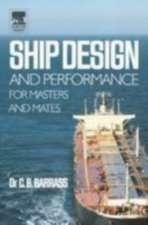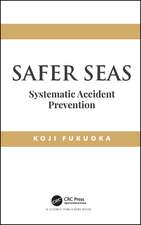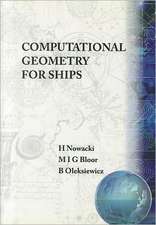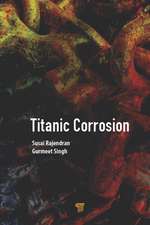Ship Stability: Notes and Examples
Autor Bryan Barrassen Limba Engleză Paperback – 12 dec 2000
The third edition of 'Ship Stability: Notes and Examples' has been updated by Dr C B Barrass, who has wide experience in both industry and the academic field. The book has been thoroughly revised and expanded to be more in line with current examinations, and now covers topics such as ship squat, angle of heel whilst turning, and moments of inertia via Simpson's Rules. Also included is a diagram showing Deadweight-Moment.
Ship Stability: Notes and Examples is an invaluable tool to aid in the passing of maritime examinations.
- Updated volume of the popular Kemp and Young series for the new Millennium
- 66 fully worked examples, with a further 50 giving final answers
Preț: 285.88 lei
Preț vechi: 339.45 lei
-16% Nou
Puncte Express: 429
Preț estimativ în valută:
54.71€ • 59.41$ • 45.96£
54.71€ • 59.41$ • 45.96£
Carte tipărită la comandă
Livrare economică 15-29 aprilie
Preluare comenzi: 021 569.72.76
Specificații
ISBN-13: 9780750648509
ISBN-10: 0750648503
Pagini: 160
Ilustrații: Approx. 100 illustrations
Dimensiuni: 148 x 210 x 10 mm
Greutate: 0.22 kg
Ediția:Revised
Editura: ELSEVIER SCIENCE
ISBN-10: 0750648503
Pagini: 160
Ilustrații: Approx. 100 illustrations
Dimensiuni: 148 x 210 x 10 mm
Greutate: 0.22 kg
Ediția:Revised
Editura: ELSEVIER SCIENCE
Public țintă
Deck officer and Marine Engineering students studying for SQA/MCA examinations. Naval Architecture / Ship Technology students on ONC, HNC, HND and degree courses. Drydock personnel, ship designers, ship classification surveyors, cargo-handling operatives, shipowner superintendents, maritime consultants etc.Cuprins
Modern ship types and characteristicsStability conceptFirst principlesSimpson's rules - QuadratureBending of beams and shipsSmall angle stabilityLongitudinal stability-trimDrydocking proceduresWater and oil pressureFree surface effectsLarge angle stabilityStability data supplied to shipsUseful formulaeHow to pass examsRevision one-linersExamples for exercise
Recenzii
"Ship Stability: Notes and Examples will be an invaluable text for those students studying the subject for the first time. It should also prove to be a useful reference tool to seagoing personnel and shore-based staff involved in ship handling." --Nicola Pryce-Roberts, MSc Maritime Operations Programme Leader, Liverpool John Moores University, June 2003
"By revising the classic Kemp and Young book, Dr Barass has brought to marine students valuable material in the ship stability domain... the author succeeds in transforming the old stability notebook into a very good self-study book that includes good explanations with very clear sketches, so that anyody can do it himself." --Captain Eli D Shiran, Seaways Journal, June 2002
"Those who have found (Ship Stability for Masters and Mates) helpful will also find the present publication useful. For each topic covered, Dr Barrass sets out the basic theory involved and then illustrates this with numerous worked examples." --E C Tupper, The Naval Architect, May 2001
"..an introduction to the topic covered that will be suitable and useful for both those who are newly at sea, and those whose practical experience is limited to narrow areas and wish to expand their knowledge." --Maritime Journal, March 2001
"By revising the classic Kemp and Young book, Dr Barass has brought to marine students valuable material in the ship stability domain... the author succeeds in transforming the old stability notebook into a very good self-study book that includes good explanations with very clear sketches, so that anyody can do it himself." --Captain Eli D Shiran, Seaways Journal, June 2002
"Those who have found (Ship Stability for Masters and Mates) helpful will also find the present publication useful. For each topic covered, Dr Barrass sets out the basic theory involved and then illustrates this with numerous worked examples." --E C Tupper, The Naval Architect, May 2001
"..an introduction to the topic covered that will be suitable and useful for both those who are newly at sea, and those whose practical experience is limited to narrow areas and wish to expand their knowledge." --Maritime Journal, March 2001
